Embodied robots have become an industry trend. Which DePIN+AI are worth paying attention to?

Reprinted from panewslab
04/27/2025·16D1. DePIN+AI builds robot paradigm in the AI era
On February 27, Messari hosted a podcast on “Building Decentralized Physical Artificial Intelligence”, inviting Michael Cho, co-founder of FrodoBot Lab. On this podcast, Michael Cho focused on the opportunities and challenges of DePIN+AI in the field of robotics.
Soon after Messari's fermentation, the concept of DePIN robot quickly became popular, and a lot of discussions about DePIN robots began to spread.
Our industry observation this week will also focus on analyzing and discussing the analysis and observation of this track with you.
Before we open our discussion, let’s take a look at the development of artificial intelligence itself on its own track:
- In computing power sector, Nvidia's quarterly revenue has increased fivefold over the past three years;
- In the bandwidth field, the construction of North American data centers has also increased fivefold in the past three years;
- In the energy field, OKLO alone requires 12.0G W, and TerraPower requires 4.0G W;
- In the data field, large companies invest more than $500 million a year to purchase wholesale data to train AI models.
Under the premise of the overall global economic downturn, AI, as the main technological revolution technology in the next ten or even twenty years, is leading all players (computing power, energy, data) on this track to accelerate with an acceleration growth rate of several times each year.
While this rapid development is also increasing, concerns about AI are also increasing. The reason is that if AI computing power (similar to the engine of a car), AI big models (similar to controllers and processors), AI energy (similar to oil and fuel), AI data (similar to raw materials) are controlled by several centralized manufacturers, then the future technology era may be completely controlled by several major manufacturers, which may lead to absolute centralization and centralization. By then, we may truly open the largest Pandora's box ourselves.
It is precisely because of the concern about such a centralized situation that a new track and direction is being hotly discussed by everyone, that is DePIN+AI. And our DePIN ONE is willing to define it as DePAI, that is, DePAI=DePIN+AI.
How will DePAI help AI to better decentralize?
We expand and analyze the main content of Messari’s podcast last month and Michael.
Currently, AI has many pain points. Although they have various functions, they are all dealing with some superficial information such as text. Such information is cold and temperatureless, and lacks deep perception and understanding.
DePIN network can become the "female features" and "limbs" of AI.
"Five Features" help AI perceive the real world in all aspects. Some developers are now using ioID and W 3 bstream to connect real-world devices to the blockchain and use zero-knowledge proof to verify their real activities.
The "limbs" can help AI make accurate judgments based on its own perception and put the judgment into action, which has achieved the system of "training" -> "modeling" -> "automation".
1. DePIN makes AI data more realistic and more diverse
Unlike those "online" AI models trained by a large amount of Internet data, DePIN devices can help AI interact with the real world and obtain more real and real-time data. Only through this data training can AI+ robots and other devices develop real embodied intelligence.
Since DePIN is still in its early stages of development, the world currently does not have such a large-scale foundation, and there is no consensus on how to collect this data.
We believe that the data to be collected by DePIN+AI in the future may be classified into the following three categories:
- The first type is human operation data, which is the data generated when humans manually control robots. This type of data is of high quality and can capture video streams and action tags - that is, what humans see and how to respond accordingly. This is the most effective way to train AI to imitate human behavior, but the disadvantage is that it is high cost and labor intensity.
- The second category is synthetic data (simulated data), which is useful for training robots to move in complex terrain. For example, training robots to walk on rough ground, which is useful for some specialized fields. But for some changing tasks, such as cooking, it is not good to simulate the environment. We can imagine the situation where a robot is trained to fry eggs: slight changes in the type of pot, oil temperature, and room conditions will affect the results, and it is difficult for the virtual environment to cover all scenarios.
- The third category is video learning, which is to let AI models learn by observing videos in the real world. While this approach has potential, it lacks the true physics direct interactive feedback required by intelligence.
If these data are collected and supported, then the AI's embodied intelligent service capabilities will definitely be greatly enhanced.
2. DePIN makes AI 's capital efficiency more powerful and is more conducive to AI decentralization from the source, rather than a puppet of some capital
Unlike traditional AI models that rely solely on computing power, the implementation of intelligent robotics requires the deployment of physical devices in the real world. This brings huge capital challenges.
Building robots is expensive, and only the richest large companies can afford large-scale experiments. Even the most efficient humanoid robots now cost tens of thousands of dollars, and it is simply unrealistic to popularize them on a large scale.
General-purpose robot AI is still far from mass adoption if the challenges of hardware, data and evaluation are taken into account.
However, the introduction of DePIN technology has given everyone hope.
Because the scale and coordination of a decentralized network can effectively diversify capital burdens, it helps some small entrepreneurial teams develop this technology. In order for general-purpose robots to speed up efficiency as soon as possible and be closer to real people, the development of robotics should be decentralized, rather than controlled by a few large companies. Rather than relying on a large company to invest in thousands of robots, it might be better to put individuals who can contribute into a shared network.
In addition, DePIN accelerates data collection and evaluation.
Without waiting for a company to deploy limited robots to collect data, the decentralized network can run and collect data in parallel at a larger scale.
For example, in a recent AI-human robot competition in Abu Dhabi, researchers from institutions such as DeepMind and UT Austin tested their AI models with human players. While humans still prevail, researchers are excited by the unique data sets collected from real-world robot interactions. This indirectly demonstrates the need for subnets connecting various components of robotics technology. Even if full autonomy remains a long-term goal, DePIN technology has demonstrated tangible value from data collection and training to real-world deployment and verification.
On the other hand, the DePIN network is helping the implementation of AI robots with higher efficiency and lower costs.
A concrete example is that FrodoBot Lab worked with the DePIN project to ensure two boxes of NVIDIA H100 GPUs — each containing the computing power supply of eight H100 chips, providing researchers with the necessary computing power to process and optimize AI models of real-world data collected from robot deployments. Without such computing resources, even the most valuable data sets cannot be fully utilized. It can be seen that through access to DePIN decentralized computing infrastructure, robotics networks allow researchers around the world to train and evaluate models without being restricted by capital-intensive GPU ownership. If DePIN succeeds in crowdsourcing data and hardware advancements, the future of robotics may arrive earlier than expected.
3. DePIN is assisting AI and AI with embodied intelligence to achieve more efficient business efficiency
A similar AI agent to Sam (a travel KOL robot with meme coins) demonstrates a new profit model for the decentralized robotics network.
Sam runs independently and broadcasts live in multiple cities on 24/7. At the same time, its meme coins are also increasing.
This model shows how DePIN-powered intelligent robots can sustain their finances through decentralized ownership and token incentives. In the future, these AI agents can even use tokens to pay for assistance from human operators, rent additional robot assets, or bid for real-world tasks, thus forming an economic cycle that is both conducive to AI development and DePIN participants.
expect
The development of embodied intelligent AI not only depends on algorithms, but also involves hardware upgrades, data accumulation, financial support and human participation.
In the past, the development of the robotics industry was limited by high costs and the dominance of large enterprises, which hindered the speed of innovation. The establishment of the DePIN robot network means that with the help of the power of decentralized networks, robot data collection, computing resources and capital investment can be carried out in a coordinated manner around the world, not only accelerating AI training and hardware optimization, but also lowering the development threshold and allowing more researchers, entrepreneurs and individual users to participate.
We also expect that the robot industry will no longer rely on a few technology giants, but will be promoted by the global community to move towards a truly open and sustainable technology ecosystem.
2. DePIN track data and observation
**1. The overall share of DePIN only accounts for 0.1% of the AI
market worth a trillion dollars**
The number of DePIN projects has increased from 100 in 2022 to 1,170 in 2024, and its market value has also soared from US$5 billion to US$50 billion, and its active node rate has increased from 2% to more than 50%. However, DePIN's overall share only accounts for 0.1% of the trillion-dollar AI market. It is no exaggeration to say that this track has 100 – 1,000 times growth potential.
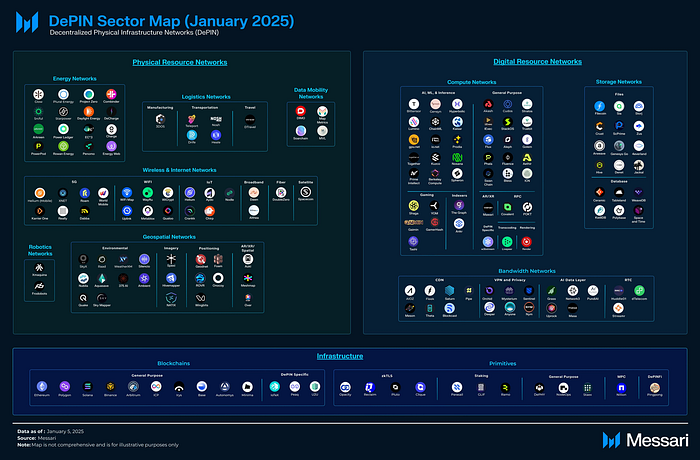
**2. DePIN financing amount increases, but the amount of financing
decreases**
According to Messari data, DePIN financing growth remained flat year-on-year, with more financing amounts but less financing in the first quarter of 2025.
First quarter of 2024: 62 rounds of financing of US$156 million.
First quarter of 2025: 36 rounds of financing of US$159 million.
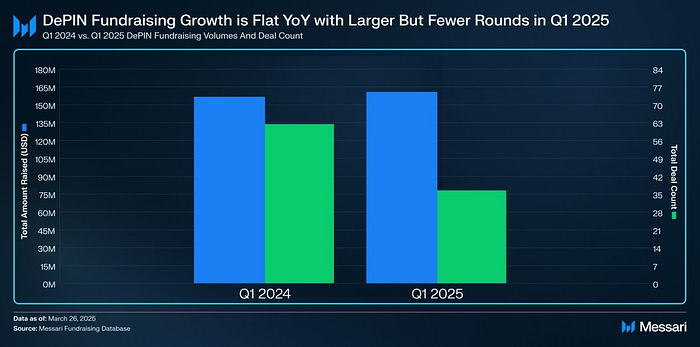
Data shows that there are fewer emerging early-stage entrepreneurial projects, but mature DePIN projects are expanding.
Currently, the global share of leading projects in the DePIN field is still very small, and it is in an absolute early stage opportunity.
The market share of wireless transmission is 0.002% (leading project Helium), the market share of computing is 0.03% (leading project Filecoin), the market share of energy is 0.001% (leading project Daylight), and the market share of identity authentication is 0.2% (leading projects Worldcoin and Anymal).
The proxy artificial intelligence market in the AI track is expected to grow significantly in the next decade, from US$520 million in 2024 to US$196.6 billion in 2034, with an annual compound growth rate of 43.8%.
**3. Grayscale releases Q2 quarterly report, focusing on RWA, DePIN and
IP tokenization**
Grayscale released its Q2 2025 quarterly report this week, focusing on RWA, DePIN and IP tokenization, so it has added three new tokens in the Top 20, namely IP, SYRUP and GEOD, while removing Akash Network, Arweave and Jupiter.
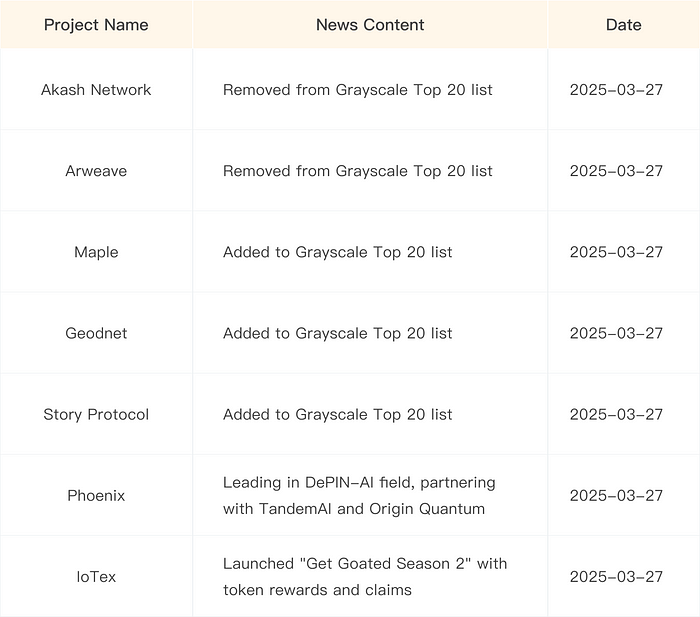
The report shows that this quarter, Grayscale will focus on tokens that reflect the non-speculative application of blockchain technology in the real world. These tokens are divided into the following three categories: RWA (real-world assets), DePIN (decentralized physical infrastructure) and IP (intellectual property tokenization).
Two of the three assets Maple (SYRUP), Geodnet (GEOD), and Story (IP) added to the Top 20 Asset List in the second quarter of 2025 are DePIN projects.
- Geodnet (GEOD): Geodnet is a DePIN project that collects real-time location data. As the world's largest real-time dynamic positioning (RTK) provider, Geodnet provides geospatial data with precision up to 1 cm, providing affordable solutions for farmers and other users. In the future, Geodnet may provide value for self-driving cars and robots. The network has expanded to over 14,000 devices in 130 countries, and annualized network expense revenue has increased to over $3 million over the past 30 days (a year-on-year increase of about 500%. It is worth noting that GEOD has a lower market cap and fewer listed exchanges compared to other assets in the top 20, so it can be considered to be more risky.
- Story Protocol: Focusing on intellectual property management on blockchain, it is more about decentralized applications than physical infrastructure, and may be marginalized in the DePIN category (Story Protocol). Story Protocol is trying to tokenize the $70 trillion intellectual property (IP) market. In the AI era, proprietary IPs were used to train AI models, leading to copyright infringement claims and mass litigation, such as previous litigation disputes between The New York Times and OpenAI. By bringing IP onto the chain, Story will enable companies to use their IP for AI model training while allowing any individual to invest, trade and earn IP royalties. Story has brought Justin Bieber and BTS’ songs to the chain and launched an IP-centric blockchain and token in February.
4. DePIN track revenue ranking in the past thirty days
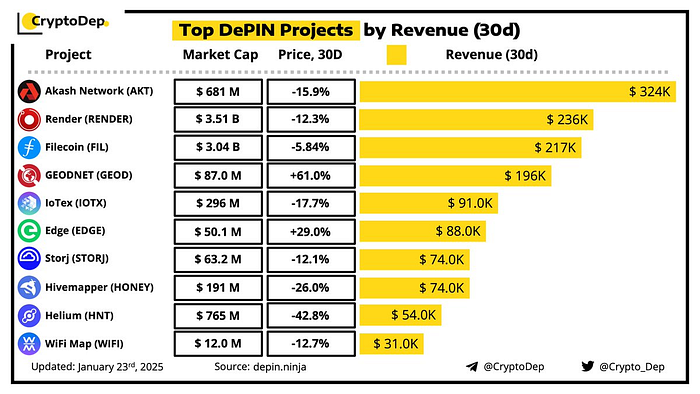
Solana\'s best performing DePIN project in the last 30 days
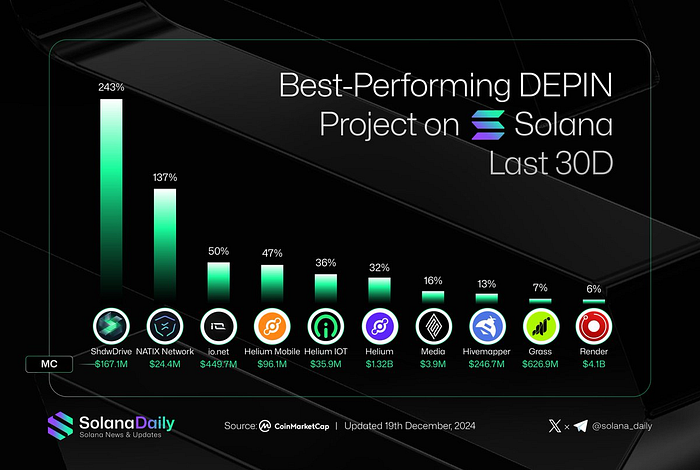
5. Industry event tracking
- Roam, an online network service that is essential for web3 people running around the world, has reached 2.8 million nodes worldwide, allowing users to achieve seamless cross-border roaming at a cost of 30% of the traditional operators. Roam plans to launch a similar incentive mechanism in the second half of 2025, with spatiotemporal data collected by distributed nodes becoming the fuel for training AI models in vertical fields.
- Phoenix, partnering with TandemAI and Origin Quantum to promote the integration of AI with decentralized physical infrastructure, is helping Phoenix be a leader in the DePIN-AI field.
- IoTeX launched the "Get Goated Season 2", which involves token rewards and claiming processes. The claim window for $IOTX has been closed on March 27, and unclaimed tokens will enter the IoTeX treasury pool. Sponsors include Geodnet, Uprock, Drop Wireless and Network 3, and the claim window will begin on April 7 with a review period from March 28 to March 31, validated using zkPass. This move may enhance community engagement and attract more users to the IoTeX ecosystem.
- According to the Helium Q4 report released by Messari, Helium network operation data has grown significantly, with operator data offloads increasing by 555% month-on-month to 576 TB, mobile hotspots growing by 14% to 24,800, and daily mobile paid traffic growing by 99%, showing its disruptive potential in the telecom industry. Meanwhile, Helium unifies $HNT as the only token through HIP 138 proposal, optimizes the economic model, and announced a partnership with Telefónica to enter the Mexican market, covering 2 million Movistar users. In addition, Helium was included in the top 20 most concerned tokens by Grayscale and included in the COIN 50 index by Coinbase, attracting the attention of institutional investors. In terms of smart city applications, the network has been used for flood monitoring and forest fire warning in the United States. Helium is expanding through the DePIN (Decentralized Physical Infrastructure Network) model to consolidate its leadership in the Web3 telecom market.
6. Financing information
- Filecoin's largest DeFi protocol GLIF released $GLF governance tokens and airdropped 94 million pieces, accounting for 9.4% of the total supply. $GLF will be expanded to new features such as loyalty rewards in the future. GLIF is expanding towards a decentralized physical infrastructure network (DePIN) beyond the Filecoin ecosystem. Currently, GLIF has locked more than US$102 million in Filecoin and will support more DePIN networks in the future.
- The decentralized business network Domin Network announced that it has received strategic investments from Animoca Brands, KuCoin Labs, Web3 Labs.club, IBC Group Official, DWF Ventures, Presto, Outlier Ventures, KnightFury, ThreeDAO, Awakening Ventures and AB DAO. Domin Network is a decentralized business network that uses NFT and DePIN Rollup technology to connect software, hardware, and consumer behavior data to the chain, which enables users to receive encrypted rewards by sharing their consumption data.

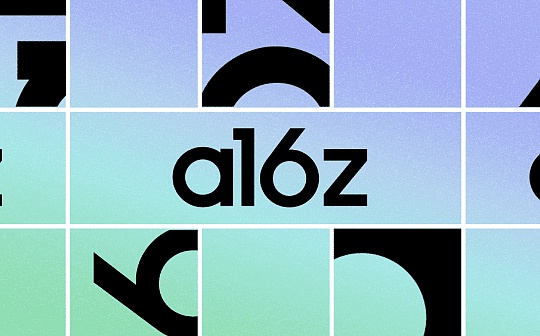
 jinse
jinse
 chaincatcher
chaincatcher